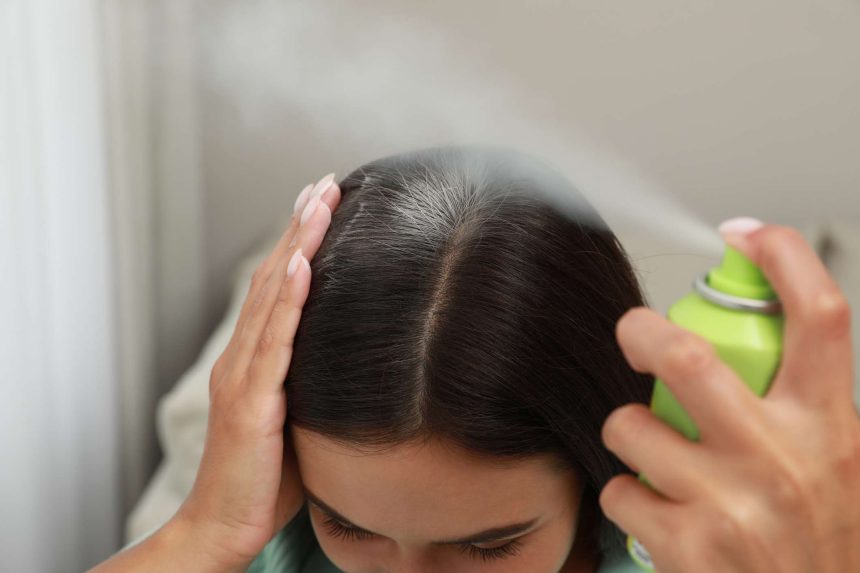Dry shampoo absorbs oil and dirt from hair without washing it. Many people use it to freshen their hair between washes or to extend the life of their color treatments.
Most experts say dry shampoo is safe to use occasionally. While it soaks up oil, it does not technically clean hair. Using dry shampoo frequently without washing your hair may cause product buildup and dandruff.
Selecting the right dry shampoo and using it properly can help you reap the benefits and minimize potential side effects and risks.
Dry shampoo is generally safe to use on occasion. However, using it too often or as a replacement for shampooing and conditioning your hair can pose some problems. Here are some potential risks of using dry shampoo:
Could Lead To Dandruff
When people use dry shampoo, they sometimes neglect regular shampooing or use too much of it, causing buildup or scalp irritation. This increases the risk of seborrheic dermatitis (dandruff). In severe cases, you may notice red, scaly patches on your scalp.
Could Lead To Dryness and Hair Breakage
Dry shampoo often contains alcohol to help dry up oil. However, this alcohol can increase the dryness of your hair, making it brittle and more prone to breakage. Excessively dry hair can crack or break, especially when you brush or comb it. When this happens, you may notice more breakage and flyaways.
Could Increase Risk of Hair Loss
While there are currently no studies that link dry shampoo to hair loss, some research shows poor scalp health could increase the risk of hair loss. Your scalp health can decline if you overuse dry shampoo or do not shampoo your hair as often as you should.
Could Cause Contact Dermatitis
Some people with sensitive skin will have an adverse reaction to dry shampoo. When this happens, they may develop contact dermatitis, an itchy skin rash caused by direct contact with a substance that causes an allergic reaction.
While overusing dry shampoo can pose a few risks to your hair and scalp health, the product is usually safe to use in moderation. The key is to make sure you’re still regularly shampooing your hair. Here are some potential benefits of using dry shampoo:
- Saves time: Using dry shampoo can save time, especially when you’re rushing from one place to another. It can also help you freshen up after a workout without needing to wash and style your hair. Reducing how often you heat-style your hair may also help preserve hair health.
- Soaks up oil: By design, dry shampoo is meant to soak up oil in your hair and extend the time between shampooing your hair.
- Adds volume: Some people use dry shampoo to freshen up their style and add volume to their hair, especially after sleep or a workout.
- Preserves hair color: Many people choose to use dry shampoo to reduce the number of times they need to wash their hair. The goal is that less frequent washing will preserve color-treated hair or highlights. Dying your hair less frequently may also help maintain hair health.
- Helps cover gray: Some dry shampoos are tinted, which can help people cover their gray hairs, especially if their hair is starting to grow out after a color treatment.
While choosing a dry shampoo often comes down to personal preference, there are factors to consider.
Dry shampoo products are available in aerosol, powder, gel, or foam forms. You should decide which form is best for you and select a dry shampoo designed for your hair type and color.
Next, consider the ingredients in the dry shampoo. If you have sensitive skin, you may want to look for a fragrance-free dry shampoo. You may also want to avoid products with formaldehyde, parabens, and phthalates. These ingredients can cause irritation, and some have been linked to cancer, hormone disruptions, and other issues.
Some dry shampoos contain talc to soak up oil, and some initial research notes that it may be contaminated with the carcinogen asbestos and could increase cancer risk. The American Cancer Society recommends avoiding products with talc if you are concerned about cancer until more research is done.
Is Homemade Better?
People on social media often recommend making your own dry shampoo using cornstarch, cocoa powder, baking soda, arrowroot, and other ingredients. They argue these versions may be more “natural,” kinder to the environment, and less expensive. However, dermatologists advise against homemade versions, especially if you hope to keep your scalp healthy.
Clumping is a common issue with homemade products, which can make the dry shampoo more visible in hair. Some “natural” ingredients can also clog pores and irritate the scalp. Some people who use homemade versions report irritation, itching, burning, and tenderness.
There’s also a risk of increased odor, especially if you use cornstarch. Bacteria can easily digest the cornstarch, creating a distinct smell and defeating the purpose of refreshing your hair with dry shampoo.
Dry shampoo is not meant to replace shampooing but to freshen hair between washes. For this reason, it should be used sparingly and not as an ongoing part of your haircare routine.
Here’s how to apply dry shampoo:
- Use your hand to lift your hair to expose the roots in oily or flat areas
- Spray a small amount of dry shampoo on the roots where you need it
- Continue to gradually spray small amounts of product in oily regions until you get the effect you want
- Follow the product instructions on how long to leave the dry shampoo on your scalp and hair to soak up the oil; some products recommend briefly massaging it into your scalp
- Brush or comb the dry shampoo out of your hair to remove the oil and refresh your hair
Try to refrain from spraying large amounts of dry shampoo at once. If you apply too much, you may irritate your scalp. Too much dry shampoo can also make your hair gritty or stiff or leave behind noticeable particles in your hair.
Continue to shampoo your hair routinely and resist the urge to skip cleansing your hair. Washing your hair and scalp with traditional shampoo and water removes dead skin cells and microorganisms that build up and can cause dandruff. It will also help remove the dry shampoo that can accumulate on your scalp and hair.
Stop using dry shampoo if you notice hair breakage, changes in hair texture, or scalp irritation. These could be signs that you are using dry shampoo too often or that the particular brand you’re using is not right for you.
You should also consider removing dry shampoo from your regimen if you notice hair loss. Research has linked hair loss to sebum (oil) buildup, infrequent washing, and scalp sensitivity.
While dry shampoo has not been directly linked to hair loss, it may contribute to some of these risk factors. If you notice changes in your hair, stop using dry shampoo for a while to see if the hair loss lessens.
Do not continue using any dry shampoo that has been recalled. Instead, throw it out. The United States Food and Drug Administration (FDA) recently announced that some dry shampoo companies engaged in a voluntary recall of their products due to the potential presence of benzene.
Benzene is a colorless or light-yellow liquid chemical that has been linked to cancer. One independent company, Valisure, analyzed 148 unique batches of dry shampoo from 34 brands and discovered that 70% contain benzene.
Most people can use dry shampoo without any issues, but some may develop scalp irritations like itching, burning, and rashes. If this happens to you, stop using the dry shampoo to see if your scalp improves.
If your symptoms do not improve or if they worsen, you should see a healthcare provider. They can evaluate your scalp and recommend how to treat your symptoms. They also can prescribe medications if needed.
Dry shampoo is a quick and easy way to freshen your hair and absorb oil between washes. It can also add hair volume and prolong color-treated hair.
However, using dry shampoo too frequently can cause dandruff, itchiness, rashes, and hair breakage. Some dry shampoo products contain ingredients that can irritate the skin or cause other health concerns.
Use dry shampoo sparingly and continue to wash your hair as normal. If you have questions about dry shampoo or if you develop a rash after using one, contact a healthcare provider.







